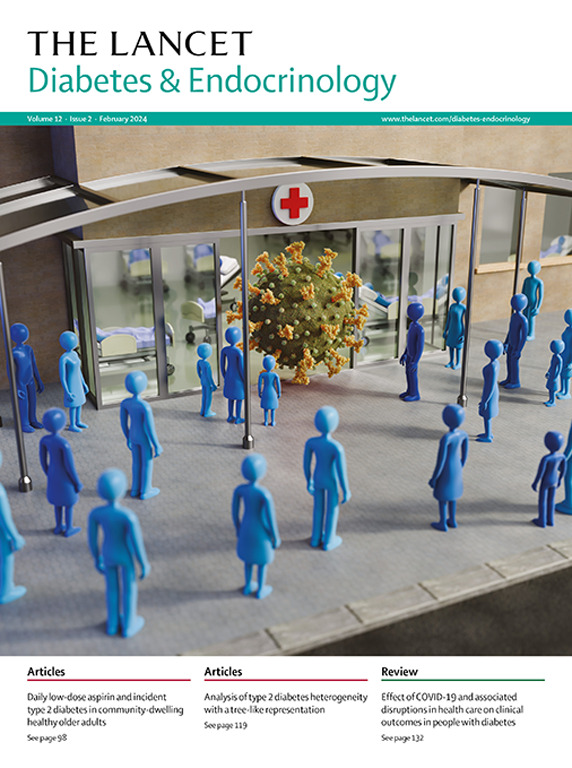基于连续血糖监测的指标和每周一次胰岛素 icodec 与每日一次格列奈胰岛素 U100 在胰岛素无效的 2 型糖尿病患者中发生低血糖事件的持续时间:对 ONWARDS 1 的探索性分析
IF 44
1区 医学
Q1 ENDOCRINOLOGY & METABOLISM
引用次数: 0
摘要
背景连续血糖监测(CGM)可对血糖控制进行全面评估。这项对 ONWARDS 1 试验的探索性分析评估了胰岛素无效的 2 型糖尿病患者在接受皮下注射每周一次的 icodec 胰岛素(icodec)与每日一次的 glargine U100 胰岛素(glargine U100)治疗时基于 CGM 的指标和 CGM 导出的低血糖持续时间。方法ONWARDS 1是一项为期78周(52周主要治疗阶段、26周治疗延长阶段和5周随访)、随机、开放标签、按目标治疗的3a期试验,在12个国家的143个地点(门诊诊所和医院部门)进行。通过交互式网络响应系统,将以前未接受过胰岛素治疗的 2 型糖尿病患者(年龄≥18 岁)(HbA1c:7-0-11-0%)随机分配(1:1)到每周一次的 icodec 或每日一次的格列宁 U100。在治疗开始(0-4 周)、试验中期(22-26 周)、主要阶段结束(48-52 周)、扩展阶段结束(74-78 周)和随访(78-83 周)期间收集了双掩蔽 CGM 数据。次要和探索性结果是基于 CGM 的指标,包括血糖范围内时间(TIR;传感器血糖 3-9-10-0 mmol/L [70-180 mg/dL])、紧范围内时间(TITR;3-9-7-8 mmol/L [70-140 mg/dL])、高于范围时间(TAR;>;10-0毫摩尔/升[180毫克/分升])、低于范围时间(TBR; <3-9毫摩尔/升[70毫克/分升]和<3-0毫摩尔/升[54毫克/分升])以及CGM得出的低血糖发作持续时间(由传感器血糖<3-9毫摩尔/升[70毫克/分升]连续≥15分钟定义的发作)。分析在全部分析集中进行(所有随机分配的参与者)。ONWARDS 1试验已在ClinicalTrials.gov上注册,编号为NCT04460885,并已完成。研究结果参与者于2020年11月25日至2022年12月1日期间注册并随机分配到ONWARDS 1(每个治疗组的人数为492人)。在治疗开始期间,我们观察到icodec与格列卫U100的TIR、TITR、TAR和TBR平均百分比无统计学显著差异。在试验中期、主要阶段末期和延长阶段末期,icodec 与格列卫 U100 相比,TIR 和 TITR 的平均百分比在统计学上明显更高,而 TAR 的平均百分比在统计学上明显更低。在这三个阶段中,使用 icodec 的 TIR 平均百分比达到了国际推荐的 CGM 目标(70%),而使用 glargine U100 的 TIR 平均百分比则未达到这一目标。在所有研究期间,两个治疗组的 TBR(<3-9 mmol/L [<70 mg/dL] 和 <3-0 mmol/L [<54 mg/dL])均较低,且低于推荐目标(分别为<4%和<1%),在较低阈值(<3-0 mmol/L [<54 mg/dL])方面,治疗组之间无显著统计学差异。在随访期间,icodec 与格列卫 U100 的 TIR、TITR、TAR 和 TBR 平均百分比在统计学上没有显著差异。在整个试验期间,治疗组之间总体低血糖发作持续时间相似(中位数持续时间≤35 分钟)。这些 CGM 数据支持 icodec 与格列卫 U100 在治疗期间的长期疗效和安全性,并表明在胰岛素免疫的 2 型糖尿病患者中,icodec 与格列卫 U100 的单次低血糖发作持续时间没有增加。本文章由计算机程序翻译,如有差异,请以英文原文为准。
Continuous glucose monitoring-based metrics and the duration of hypoglycaemia events with once-weekly insulin icodec versus once-daily insulin glargine U100 in insulin-naive type 2 diabetes: an exploratory analysis of ONWARDS 1
Background
Continuous glucose monitoring (CGM) can provide a comprehensive assessment of glycaemic control. This exploratory analysis of the ONWARDS 1 trial assessed CGM-based metrics and CGM-derived hypoglycaemia duration in insulin-naive individuals with type 2 diabetes treated with subcutaneous once-weekly insulin icodec (icodec) versus once-daily insulin glargine U100 (glargine U100).Methods
ONWARDS 1 was a 78-week (52-week main treatment phase and a 26-week treatment extension phase plus a 5-week follow-up), randomised, open-label, treat-to-target, phase 3a trial done at 143 sites (outpatient clinics and hospital departments) across 12 countries. Adults (aged ≥18 years) with type 2 diabetes (HbA1c: 7·0–11·0%) who had not previously received insulin were randomly assigned (1:1) via an interactive web-response system to once-weekly icodec or once-daily glargine U100. Double-masked CGM data were collected during treatment initiation (weeks 0–4), midtrial (weeks 22–26), end of main phase (weeks 48–52), end of extension phase (weeks 74–78), and follow-up (weeks 78–83). Secondary and exploratory outcomes were CGM-based metrics, including the mean percentages of time in glycaemic range (TIR; sensor glucose 3·9–10·0 mmol/L [70–180 mg/dL]), time in tight range (TITR; 3·9–7·8 mmol/L [70–140 mg/dL]), time above range (TAR; >10·0 mmol/L [>180 mg/dL]), and time below range (TBR; <3·9 mmol/L [<70 mg/dL] and <3·0 mmol/L [<54 mg/dL]), and CGM-derived hypoglycaemic episode durations (episodes defined by sensor glucose <3·9 mmol/L [<70 mg/dL for ≥15 consecutive minutes]). Analyses were done in the full analysis set (all randomly assigned participants). The ONWARDS 1 trial is registered with ClinicalTrials.gov, NCT04460885, and is complete.Findings
Participants were enrolled and randomly assigned in ONWARDS 1 between Nov 25, 2020, and Dec 1, 2022 (n=492 in each treatment group). During treatment initiation, we observed no statistically significant differences in the mean percentages of TIR, TITR, TAR, and TBR with icodec versus glargine U100. During the midtrial, end of main phase, and end of extension phase periods, the mean percentages of TIR and TITR were statistically significantly greater and the mean percentages of TAR statistically significantly lower with icodec versus glargine U100. The mean percentages of TIR met the internationally recommended CGM target (>70%) with icodec but not with glargine U100 during the three periods. TBR (<3·9 mmol/L [<70 mg/dL] and <3·0 mmol/L [<54 mg/dL]) was low and below recommended targets (<4% and <1%, respectively) across all study periods in both treatment groups, with no statistically significant differences between treatment groups for the lower threshold (<3·0 mmol/L [<54 mg/dL]). During the follow-up period, mean percentages of TIR, TITR, TAR, and TBR did not statistically significantly differ with icodec versus glargine U100. The duration of overall hypoglycaemic episodes was similar between treatment groups throughout the trial (median duration ≤35 min).Interpretation
These CGM data support the long-term efficacy and safety of icodec versus glargine U100 during treatment and indicated no increase in the duration of individual hypoglycaemic episodes with icodec versus glargine U100 in insulin-naive individuals with type 2 diabetes.Funding
Novo Nordisk.求助全文
通过发布文献求助,成功后即可免费获取论文全文。
去求助
来源期刊

The Lancet Diabetes & Endocrinology
ENDOCRINOLOGY & METABOLISM-
CiteScore
61.50
自引率
1.60%
发文量
371
期刊介绍:
The Lancet Diabetes & Endocrinology, an independent journal with a global perspective and strong clinical focus, features original clinical research, expert reviews, news, and opinion pieces in each monthly issue. Covering topics like diabetes, obesity, nutrition, and more, the journal provides insights into clinical advances and practice-changing research worldwide. It welcomes original research advocating change or shedding light on clinical practice, as well as informative reviews on related topics, especially those with global health importance and relevance to low-income and middle-income countries. The journal publishes various content types, including Articles, Reviews, Comments, Correspondence, Health Policy, and Personal Views, along with Series and Commissions aiming to drive positive change in clinical practice and health policy in diabetes and endocrinology.
 求助内容:
求助内容: 应助结果提醒方式:
应助结果提醒方式:


